Fun Facts …… Tom James
Fuel injection was added for 1967, but unlike the modern electronic-fuel injection (EFI) systems we use today, the Ram Jet fuel injection unit was mechanical. That is, instead of having an electric fuel pump and electronically cycled solenoid-style injectors, the pump was driven (at half engine speed) by a cable attached to the ignition distributor housing. The injectors were simple nozzles inserted near the base of the manifold runners and were always open for a constant flow system.
With the mechanical fuel pump driven by the distributor shaft, it delivered fuel pressure the entire time the engine was running. A three-piece bypass valve assembly regulated the pressure of fuel delivery. An air meter sensed engine vacuum (throttle position) and signaled the pressure regulator to direct full fuel flow to the nozzles (for power) or return some of it to a reservoir (light load, idle). Fuel pressure ranged from about 3 psi to 200 psi.
The primary goal of the Rochester fuel-injection system was to eliminate the fuel-slosh problem encountered with carburetors on road-race circuits. All Corvette carburetors relied on integral reservoirs (called bowls) to maintain a steady supply of gasoline, ready to be drawn into the engine by vacuum. However, during hard corners, lateral G-forces could pull the raw gasoline away from metering orifices and cause fuel starvation and power loss/stalling, not the way to win races. With its constant pressurized flow, mechanical flow injection (and modern EFI) was a solution.
How Chevy Builds a Corvette ZR1 That Shames Hypercars Costing Three Times More
Story by Amos Kwon
American firepower without the bespoke pricing
2025 Chevrolet Corvette ZR1 Chevrolet© Chevrolet
The $174,995 price tag for the Chevrolet Corvette ZR1 is the highest ever for a Corvette (soon to be eclipsed by the all-wheel drive ZR1X), but compared to even the cheapest models from Ferrari, Lamborghini, and McLaren, the ZR1 is a downright bargain. Not only is it less expensive than even the cheapest supercars from ultra-premium brands, but the ZR1 also delivers astounding levels of performance that bests Ferrari and Lamborghini hypercars that cost three times more. How is Chevy able to do this for so much less than the others? We take a closer look.
Way cheaper than the exotics
2025 Chevrolet Corvette ZR1 Chevrolet© Chevrolet
The ZR1’s price seems stratospheric for even a top-tier Corvette, but it pales in comparison to other brands’ less capable entry-level models. The Ferrari Roma, the cheapest Ferrari sold today, costs $279,965. The upcoming Lamborghini Temerario will cost around $290,000, making it the least expensive Lamborghini supercar. The $254,100 McLaren Artura costs less than the Ferrari and the Lamborghini, but it’s still $80 grand more than the ZR1. You can buy a BMW M4 with the leftover funds.
2025 Chevrolet Corvette ZR1 Chevrolet
The Corvette ZR1 isn’t compromising anything in the way of performance, and that’s been proven on the drag strip. The Corvette ZR1 is powered by a twin-turbo 5.5-liter LT7 engine that churns out 1,064 hp and 828 lb-ft of torque, mated to an 8-speed dual-clutch transmission, making it the most powerful V8 Chevy has ever created. 0-60 comes in a scant 2.3 seconds, and it tops out at 233 mph. According to Motor1, the ZR1’s output numbers might be even higher than Chevy stated. It looks like the ZR1 might be closer to 1,180 horsepower and 920 lb-ft based on dyno figures and after estimated drivetrain losses.
reveulto
A recent drag race video between the Chevy Corvette ZR1, the Lamborghini Revuelto, and the Ferrari SF90 reveals the ‘Vette’s immense straight-line capability. In a quarter-mile sprint, it bests both the Ferrari and the Lamborghini. The ZR1 isn’t as quick as the Revuelto off the line, but it cooks the SF90 from the get-go. As the speeds increase, the powerful twin-turbo V8 ZR1 starts to catch up to the Revuelto, and the Ferrari never gains on it. At the end, it’s the ZR1 that takes the quarter-mile crown, an impressive feat for a car Ferrari and Lamborghini owners might ordinarily look down on. Not anymore.
6079b891-13fb-4fd4-9970-6004ac79613c
Chevrolet rates the Corvette ZR1 at 9.6 seconds at 152 mph. In the actual drag race with the Revuelto and the SF90, the ZR1 did it in 9.8 seconds at 146. That might be a tad slower than Chevy stated, but keep in mind that the twin-turbo V8 in the ZR1 only powers the rear wheels, whereas the V12 Revuelto with three electric motors (1,001 hp, 787 lb-ft) and the twin-turbo V8 SF90 with three electric motors (986 hp, 590 lb-ft) can’t keep up with the ZR1. To boot, the Revuelto costs $608,358, and the SF90 is priced at $528,764. Each one costs over three times more than the ZR1. The ZR1 is a supercar that’s destroying hypercars two at a time.
The ZR1 delivers insane performance without a colossal price tag
2025 Chevrolet Corvette ZR1 Chevrolet© Chevrolet
The Chevrolet Corvette has long been a symbol of attainable performance, beginning with the C4 in 1983. Now in mid-engine configuration for the first time, the 2025 C8 Corvette Stingray (490-hp 6.2-liter naturally-aspirated V8 engine) ups the ante. It accelerates from 0 to 60 mph in 2.9 seconds and attains a top speed of 195 mph. It also hangs on with authority, providing 1.03 lateral g’s. This is the entry-level Corvette, folks. All this for a base price of $68,300. The C8 Corvette in any trim delivers supercar thrills at a fraction of the price. With the arrival of the ZR1, Chevrolet has built a world-beating supercar that holds nothing back.
2025 Chevrolet Corvette ZR1 Chevrolet© Chevrolet
The ZR1 uses a twin-turbocharged version of the Z06’s 5.5-liter flat-plane crank V8. The Z06’s engine already revs to 8,600 rpm and makes 670 horsepower without turbocharging. The ZR1’s two turbos send this number to 1,064 horsepower. The upcoming all-wheel drive ZR1X will throw down 1,250 horsepower to all four wheels. We can’t imagine what its performance numbers will look like.
GM’s sheer size and economies of scale keep costs low for the ZR1
2025 Chevrolet Corvette ZR1 Chevrolet© Chevrolet
One of the biggest contributing factors to the ZR1’s comparatively low price is that Chevrolet can deliver this power using proven, mass-produced components. By leveraging economies of scale and existing architecture, they avoid the costs that come with bespoke powertrains seen in the likes of a Ferrari SF90 or Lamborghini Revuelto, both of which use powertrains not found in their other models. Each one has its own sophisticated plug-in hybrid setup. The ZR1 does not. GM’s extensive testing and engineering can ensure reliability even with the added boost, something that often plagues smaller-volume supercar makers that don’t build anything other than high-performance.
One of Chevrolet’s most potent tools is the manufacturing might of the General Motors juggernaut. The Bowling Green, Kentucky, plant that builds the Corvette can churn out thousands of cars per year using highly refined dnd time-proven processes. This is something that boutique supercar brands simply can’t match. By building the ZR1 alongside Stingray and Z06 models, Chevrolet can leverage shared components and production efficiencies, suppliers can offer better pricing thanks to higher volume orders, and quality control benefits from systems honed over decades of mass production.
2025-z06-gallery-ext-07
Corvettes, overall, are typically less expensive than Ferraris, Lamborghinis, or McLarens primarily due to differences in production volume, materials, and brand positioning. For example, Ferrari only built 799 SF90 Stradale coupes and 599 SF90 Spiders, but Chevy says they will build as many ZR1s as the market demands. Corvettes are mass-produced with shared components, while Ferraris are known for their exclusivity and hand-built processes. This results in higher production costs and prices. Chevrolet can offer similar or superior performance at a fraction of the cost.
The ZR1 packs what’s necessary rather than what’s perceived as exotic
2025 Chevrolet Corvette ZR1 Chevrolet© Chevrolet
Supercar manufacturers often rely on very expensive materials like carbon fiber monocoques to save weight and add stiffness. Do they work? Yes, but the C8 platform has been proven to work marvelously. The aluminum spaceframe offers impressive rigidity without the cost of developing and manufacturing carbon tubs. Carbon fiber requires a complex manufacturing process, and it costs over forty times more than aluminum.
2025 Chevrolet Corvette ZR1 Chevrolet© Chevrolet
The ZR1 also utilizes carbon fiber aerodynamic components (splitters, diffusers, wings) where they matter most, without overusing expensive materials. The massive rear wing is adjustable and creates tremendous downforce without the use of active aero, which is pricier and utilized for a certain look. On top of that, the ZR1 also uses underbody panels to reduce lift rather than a complex active aero system that adds expense. For the ZR1, Chevrolet can push this even further with Magnetic Ride Control 4.0 for adaptive damping that rivals or exceeds systems on cars costing far more, and that tech isn’t just used for the ZR1 but across other GM models. The ZR1’s approach is more functional than aesthetic, and that keeps costs lower.
A cabin that works well for the price and intended purpose
2025 Chevrolet Corvette ZR1 Chevrolet© Chevrolet
Pricey exotics like the $2.5 million Pagani Utopia have impressive interiors using gobs of billet aluminum for an artisanal interior that’s unique to the model. At the opposite end of high-performance cars, the ZR1 uses the same design and materials as the Stingray but with some upgrades. It’s not a unique interior in terms of design, and that saves on costs, too. What’s more, high-end supercars often load up on tech, and these systems can be costly, and in some cases, unnecessary for the pure driving experience. Chevrolet can prioritize: A simple, high-quality digital cluster that provides important driving data along with a useful infotainment system and good switchgear.
2025 Chevrolet Corvette ZR1 Chevrolet© Chevrolet
You won’t see optional packages for the ZR1 that cost tens of thousands of dollars and can drive up the price of a car into the stratosphere. The most expensive options are $13,995 carbon fiber wheels and the $8,495 ZR1 Carbon Fiber Aero Package. Even special paint colors like the Competition Yellow Tintcoat Metallic in some of these photos won’t set you back more than a grand.
Ferrari will charge tens of thousands for exposed carbon interiors, special stitching, or custom paint. Chevrolet doesn’t bog down the price of the ZR1 with near-endless aesthetic options. Of course, if you want fancier looks, like two-tone seats or special badging, the prices are quite reasonable for the ZR1, not more than a few hundred dollars. You won’t see anywhere near those prices for the European steeds.
Final thoughts
The Corvette ZR1 represents more than just the next step in the C8’s evolution. It’s a chance for Chevrolet to remind the world that you don’t need to spend half a mil or more to enjoy world-beating performance. By focusing on smart engineering, leveraging mass production, and refusing to get caught up in the excesses that drive supercar prices sky-high, Chevy can deliver a ZR1 that obliterates expectations and lap records alike. The upcoming ZR1X will show off its wares and firepower soon, proving even more that the C8 Corvette’s premium iterations can best the most expensive cars in the world.
Corvettes at Carlisle to welcome first Corvette ever produced
Corvettes at Carlisle will return this summer, and it will feature the Corvette considered to be the very first one to roll off the assembly line.
A 1953 C1 (Engineering Car #3950) has been confirmed for the event Aug. 21-23.
For decades, automotive historians believed the first two production Corvettes had been destroyed shortly after being manufactured.
So how did this one end up in Carlisle?
It’s all thanks to a major effort by Corvette enthusiasts Corey Peterson and John Amgwert.
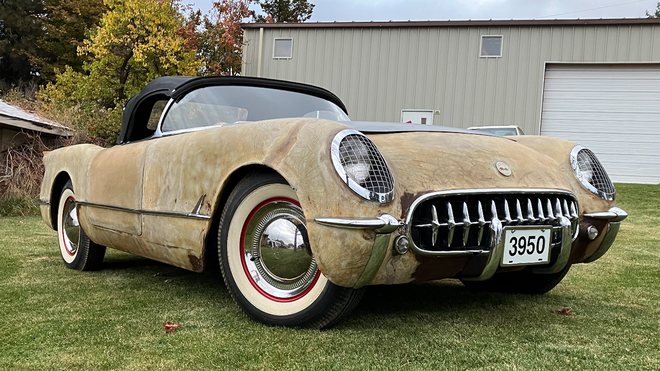
Carlisle Events
Peterson and Amgwert began their investigation after identifying inconsistencies in the official historical record. Convinced that these early Corvettes may still exist, their research spanned over two decades and multiple states.
Their perseverance paid off in 2023 with the discovery of a vehicle stored in an Oklahoma restoration shop.
The car was initially suspected to be the second Corvette ever built, but research and documentation determined if it was actually the very first production 1953 Corvette ever assembled.
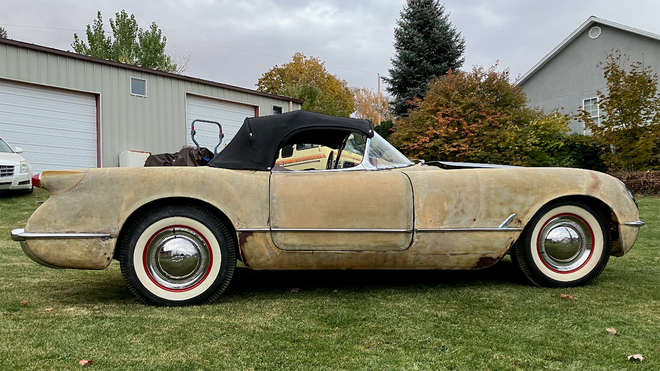
Carlisle Events
“We always believed the cars were out there somewhere,” Peterson said. “Confirming that we had located Corvette #3950, the very first production model, is beyond what we could have imagined. We are thrilled to share this incredible discovery with the Corvette community at Carlisle.”
Visitors to Corvettes at Carlisle have the rare opportunity to see the car up close.
Peterson and Amgwert will also be in attendance to give presentations and hold Q&A sessions that chronicle what led up to the historic discovery.
More information about Corvettes at Carlisle is available at carlisleevents.com.
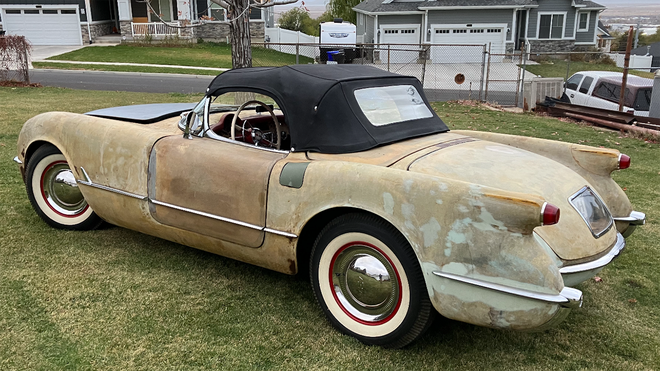

When you think of your Corvette, the steering wheel is probably not the first thing that comes to mind. It is, however, the part of your Corvette that gets the most contact when out on the road. It is not uncommon for your steering wheel to see excessive wear, in comparison to the rest of your car, due to frequent use.
This guide identifies the design and features of Corvette steering wheels by year group. Depending on your Corvette generation and style preference, you have several options for bringing your steering wheel back to life. From purchasing a reproduction steering wheel, to getting your steering wheel refurbished and even upgrading to a custom steering wheel, the right steering wheel is out there for every generation.
1953-1955
- 17″ In Diameter
- Plastic Spokes
- White In Color
- Chrome Horn Button

1956-1962
- Stainless Steel Spokes
- Three Chrome Spokes
- Spokes Had 3 Holes Per Spoke
- 17” Diameter
- Color Of Wheel Matched Interior Color
- 1956-1957 Venetian Red
- 1956-1957 Shoreline Beige
- 1958 Charcoal
- 1958 Signet Red
- 1958 Blue
- 1959-1960 Turquoise
- 1959-1960 Frost Blue
- 1959-1962 Roman Red
- 1959-1962 Tuxedo Black
- 1961 Jewel Blue
- 1961-1962 Fawn Beige
- Riveted To Hub Making It Difficult To Replace
- Reproduction Steering Wheels Available
- Flat Steering Wheel

1963
- One Year Only Steering Wheel
- 16” In Diameter
- Reproduction Steering Wheels Are Available
- Color Matched Interior
- Saddle
- Red
- Dark Blue
- Blue
- 130 Cars Received The Option For Simulated Wood Grain
- Three Spokes
- Long Slot In Each Spoke

1964-1966
- Flat Hub
- Simulated Walnut Finish
- 6 Philips Head Screws Attach Steering Wheel To Hub
- Reproduction Steering Wheels Available
- Aftermarket Steering Wheels Available
- 1965-1966 Option For Real Teak
- 16” Diameter

1967-1968
- Offset Hub

1969-1975
- Black With Leather Grain Pattern
- Fit Standard And Telescopic Steering Columns

1976
- Same Steering Wheel As The Chevy Vega
- One Year Only

1977-1982
- Floating Round Horn Button
- 14” In Diameter

1984-1985
- 14.5” Diameter
- Black Leather
- Thinner Wheel Than The Later 1986-1989 Wheel

1986-1989
- All Black Except 1988 Anniversary White
- Used Same Armature As 1984-1985 With Thicker Urethane
- Round Horn Button
- Available As Remanufactured
- 2-Tone Wheels Are Available For An Upgraded Look

1990-1993
- 1990 First Year For Air Bag In Steering Wheel
- Offered As A Restoration Service For Original Steering Wheel
- Leather Steering Wheel
- All Black
- 4 Spoke
- Corvette Script
- Horn Buttons On The Outside Spokes With Plastic Gray Buttons

1994-1996
- 2 Spoke
- C4 Corvette Logo
- Horn Button In The Center

1997-2004
- C5 Corvette Logo In The Center
- Decals Available For Logo To Add Color
- All Black Except The 2003 50th Anniversary And 2004 Le Mans Corvette

2005
- One Year Only Steering Wheel
- 4 Spoke Design
- Ebony

2006-2011
- 9.4” In Diameter
- Steering Wheel Mounted Audio Controls Included With Bose Audio Systems
- Available In Suede Or Leather
- Available With Accessory Controls And Without Accessory Controls
- 2010 Steering Wheel Was The First Year For Bluetooth
- 2011 Steering Wheel Available With Accent Stitch
2005-2011 Corvettes have aftermarket steering wheels available some benefits include:
- Aesthetics – A custom steering wheel can be altered to build your personal preference of the look you need and still having that OEM look after installing
- Ergonomics – Custom steer wheels are shaped in multiple areas of hand position to help with driver fatigue and to help avoid hand cramping.


2012-2013
- New Steering Wheel Design Offers New Chrome Trim Around Controls

2014
- Smallest Steering Wheel Corvette Has Ever Made
- Paddles On Steering Wheel (Manual Transmission) Are On/Off Switches For The Standard Rev-Matching Feature
- Accessory Features Include Audio Volume Controls, Audio Next/Previous Control, Cruise Control Buttons, Advanced Theft Protection, And Bluetooth Controls

Wheel Cover Design Changes for the 1953-1955 Corvette
By: Bill Mulder
Recently, an ad appeared for ‘original’ 1954 Corvette wheel covers on EBay and the wheel covers did not have the traditional flippers which prompted this summary. There were essentially 3 different versions of the wheel cover and what wheel cover belongs on what car depends on what time period the car was created.
Temporary Belair passenger car wheel cover (cars 1-20?)
This was placed on the first approximately 20 cars until flipper wheel covers came available. We know this because of an early photo of the 10 early Corvettes lined up for view, photographing and driving by journalists and the cars had passenger car wheel covers.
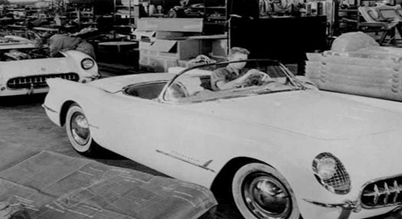
The very first version was a wheel cover with the Chevrolet Bowtie at 90 degrees from the flippers which was on the two Motorama cars. Below you can see this is a Motorama car as it has an external door ‘pushbutton’ that was not placed into production as well as the door missing its side trim, the front fender trim is mounted upside down and the fender vent that did not come until 1956. If you look close, you can see the 90 degree flippers.

We do know that the Motorama wheel cover with the 90 degree flipper was placed into production but we do not know when it stopped. Russ Howay has car #68 and it has the 90 degree flippers so likely sometime after car 68 the wheel cover changed.
Below is an original 90 degree flipper wheel cover made by the Lyon manufacturing company. Note the flippers are not lined up with the bowtie emblem. Also, for later reference, note that the red painted indentation lines up with the valve stem.
1953 early 90 degree wheel cover
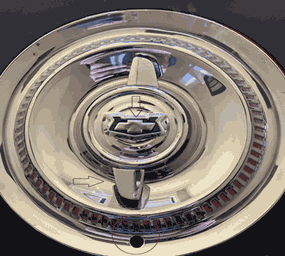
More traditional in-line wheel cover 53-55
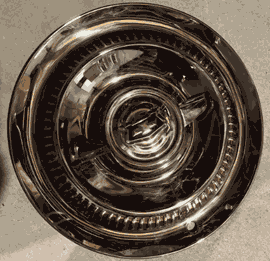
Version 2 production (cars 70-300 in 53 and some in 54).
The wheel cover was changed from the 90 degree flipper to the wheel cover with the flipper in line with the Chevrolet Bowtie. This wheel cover has the ‘grippers’ that held the wheel cover onto the wheel in-line with the valve stem causing some problems which resulted in a change. Also, for some odd reason the red painted indentation does not line up with the valve stem as it did with the original 90 degree flipper wheel cover.
Below is a typical ‘53’ wheel cover with the ‘gripper’ and valve stem in line and red indent not in line.
Gripper in line with valve stem
Red painted indent not in line with valve stem
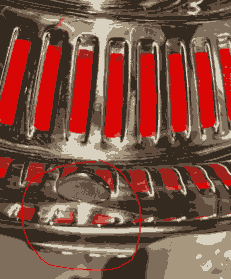

Version 3 late 54 and all of 55
Gripper moved to not be in line with valve stem and the red painted indent lined up with valve stem.

When did the change occur?
I have an original set of plans dated 8/7/54 and states it is the same as plan 3706423 except as shown. This is the first plan that shows the red painted indentation in line with the valve stem and the gripper not in line with the valve stem.

Note that the plan refers to the predecessor plan below which is a much larger and detailed plan refers to initial drawings in March of 1953 and states there are 5 changes. It appears there were other changes from 53 to fall of 54 when these versions were approved. The fall of 1954 plans indicate there is a 3rd intermediate step wheel cover between what most people consider to be the 53 wheel cover and the 54-55 wheel cover.
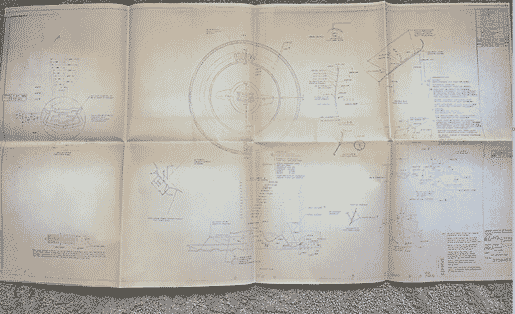
The NCRS judging manual which states there are only two primary designs. First, the 53 wheel cover with the gripper in line with the valve stem and the red pained indention is not lined up with the valve stem. The second design is the 54-55 wheel cover that has the red painted indention and the valve stem in line and the gripper moved offset from the valve stem.
However, there may be a 3rd group of wheel covers out there with a mix of 53 and 54-55 attributes. Below is an example of what should not exist. Note the gripper lines up with the value stem (53 design) and the red painted indention lines up with the valve stem (54-55 design).
Note red indent line points straight at valve stem
Note valve stem and gripper are in line also (which should not occur)
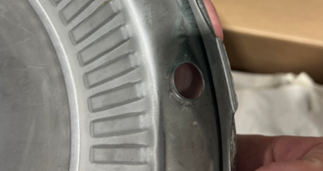
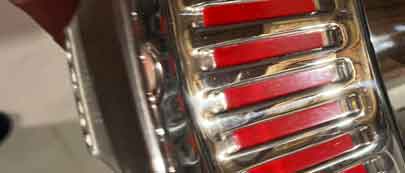
This is an example of what is likely a short lived change as the wheel cover evolved with the car.
Why did the grippers get moved?
Corey Peterson provided the following photos to support his belief that the change to move the grippers was because GM knew in the fall of 54 that the new 55 wheel was coming out and the new wheel had nubs on the rim for the new passenger car wheel cover. He believes the location of the grippers would hit the nubs making it difficult to remove the wheel cover. As proof, note the new 1955 wheel with tape marking the location of the nubs:
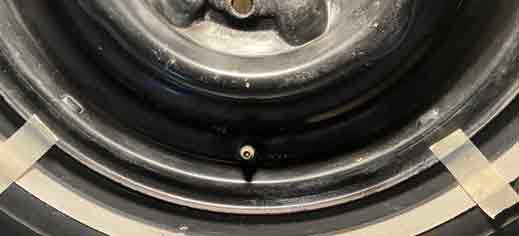
Note that with a 1953 through fall of 1954 style wheel cover, the grippers do hit the newly created nubs for the 1955 wheel.
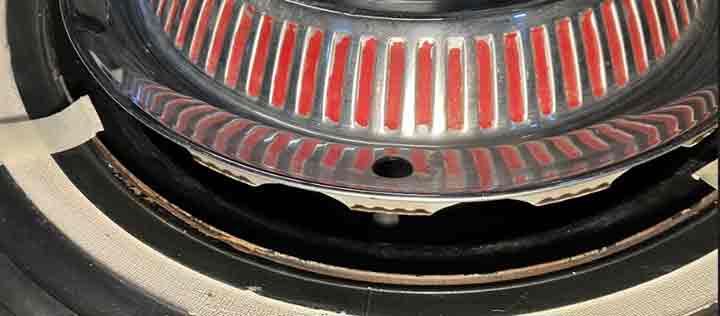
By changing the location of the grippers, they do not hit the nubs for the new 1955 wheel cover.
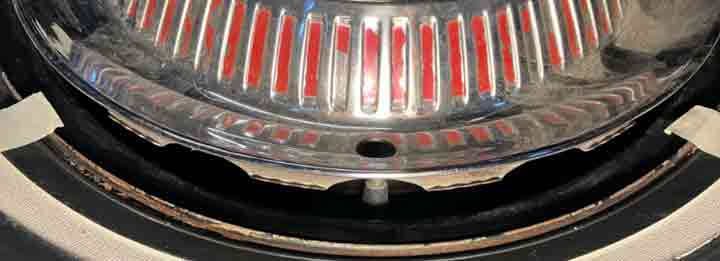
It seems much more likely that the grippers were moved in the fall of 1954 to accommodate the new 1955 wheel that had newly added nubs. If there was a problem with the valve stem, a change would likely have occurred earlier than fall of 1954. Also, Lyons Manufacturing was the world’s largest manufacturer of wheel covers having started making them in the 1930s. It is unlikely they would have made a rookie mistake and located the grippers in such a way to affect the valve stem.
Real or reproduction flippers?
Corvette Central Reproduction
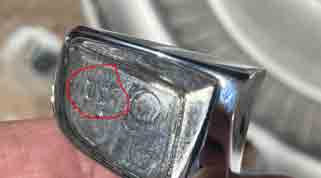
Originals
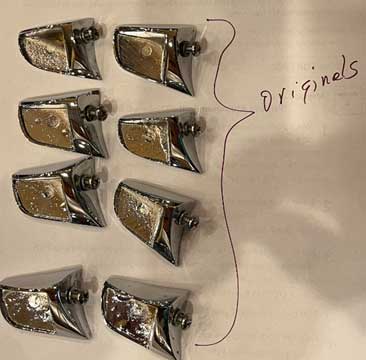
Original or re-issue hub caps?
The seller on EBay states these are new and original 1953-55 wheel covers but they have no flippers or any indentation to install the flippers. This is because GM re-issued these in the 1970s but because of Ralf Nader and safety, GM did not place flippers on the wheel covers. So, they would be service replacements.
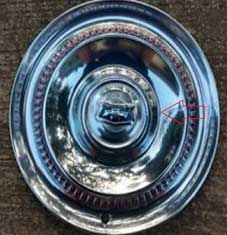
There are experts that will indent these wheel covers to make a 90 degree flipper or to make the more traditional wheel cover with the flippers in line with the Chevrolet Bowtie. However, they are different from the originals as the originals have indented on the rim the words “PAT PEND”, PATENTED”, “LYON” (the manufacturer) and “WHEEL COVER”. The GM replacements do not have these marks.

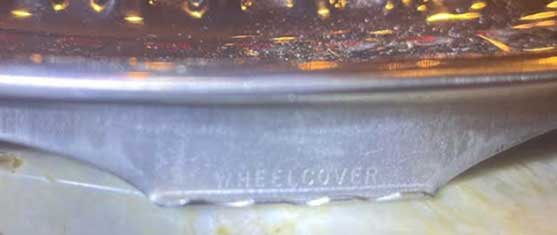
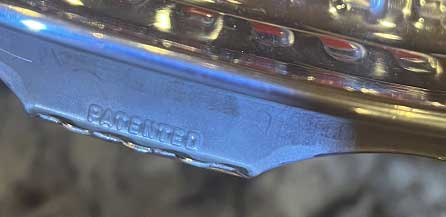
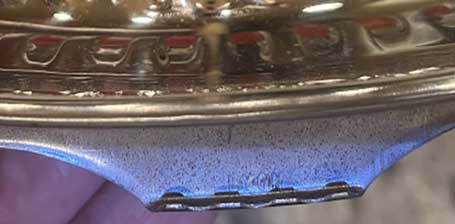
Conclusion
The car went through a lot of changes and this is just one example of the amount of change. To date a wheel cover by determining if the red painted indention lines up with the valve stem may be harder than one thinks as there were several design changes. And if you find a 90 degree













